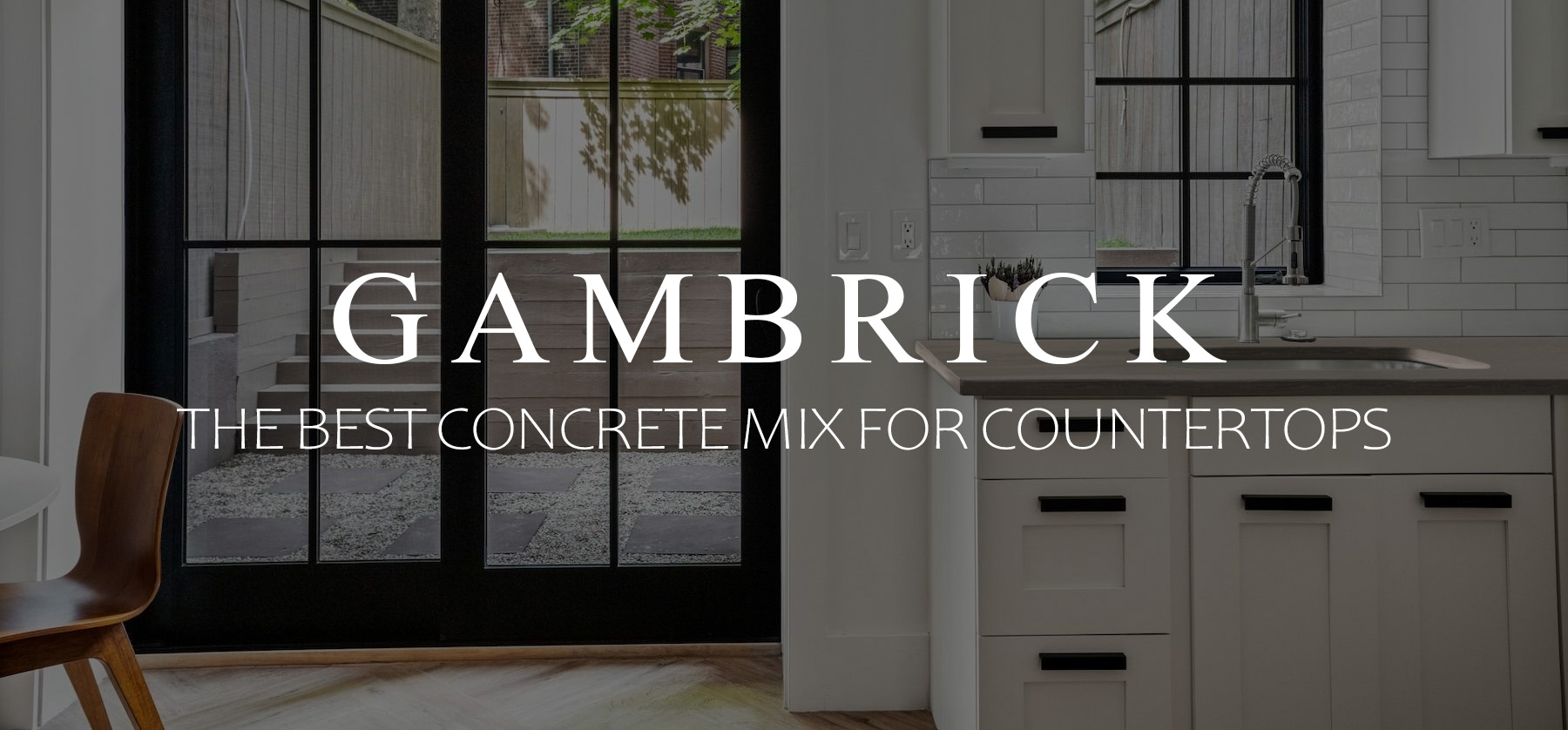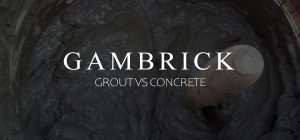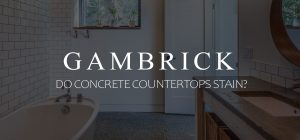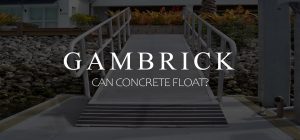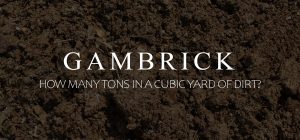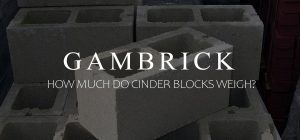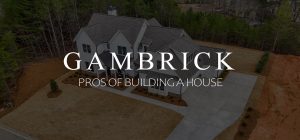The Best Concrete Mix For Countertops
Concrete is a fantastic material that’s used all over the world to build everything from residential homes to large scale buildings, damns, bridges and yes, even countertops. In fact, modern concrete countertops are one of the hottest trends in kitchen design. They’re strong, durable, stylish, affordable and extremely versatile. But you have to use the right concrete mix for countertops in order to get the best results. A standard concrete mix used for patios just won’t do.
The best concrete mix for countertops is one with high compressive strength, smaller, rounder stones and some flexibility. QUIKRETE® Countertop Mix (No. 1106-80, -81) is a specially formulated high-strength concrete mix for pre-cast and cast-in-place concrete countertops. It works really well and comes in 80 pound bags.
If you prefer mixing your own batch, the formula I use is 1 part Portland Cement, 2 parts sand and 3 parts small round stones. Use just enough water to activate all the cement and not a drop more. Watery concrete is not good for cast in place concrete countertops. Mix in some chemical additives, micro-rebar or fibers to increase strength and flexibility. The end result should be a 6000 PSI concrete with some flexibility.
In addition to using the right concrete mix and additives, make sure to include reinforcement like rebar and wire mesh inside the slab because concrete countertops can crack without them.
The key to making strong concrete countertops is using the right concrete mixture, building strong forms, using reinforcement, and jigging the concrete to release air bubbles.
What Type Of Concrete Is Best For Countertops?
You shouldn’t use just any concrete mix for countertops. Most standard concrete mixes are designed for structural jobs like pouring footings, a sidewalk or setting a fence post. The best concrete mixes for countertops use smaller stones which provide a smoother surface and additives to increase strength and flow. This means concrete will penetrate into the corners and won’t hold as many air bubbles. The finish will be smoother and more consistent, which is what you want from a countertop.
- Concrete countertop mixes use additives to increase strength and reduce cracks.
- Other additives are used to make the concrete flow better. This makes it easier to jig the concrete and release air bubbles.
To build the best countertops, you need the right concrete mix. You have two main options, buy pre-mixed concrete or make your own batch.
A good mix for concrete countertops should do the following:
- Have a low water-cement ratio to prevent shrinkage cracks.
- Provide high compressive strength.
- Be easy to work with.
- Have good surface quality.
When choosing a mix, consider any special effects you want to achieve like veining, colors and shine.
If this is your first time making concrete countertops, I recommend buying premixed. It works great and everything’s already been figured out for you. You don’t have to worry about ingredient ratios. Just use the correct amount of water and pour it into the forms.
However, if your experienced with concrete countertops and need something special, you can mix your own. Mixing your own concrete is the best way to control how it’ll perform during the job and after the concrete has hardened.
Concrete Countertops Need Very Strong Concrete
Strength is essential when creating concrete countertops because the slabs are typically large but thin, averaging just two inches thick. At this thickness, concrete is prone to cracking. But Quikrete Concrete Mix uses additives that increases strength and resists cracks.
Concrete countertops will see a lot of use in your kitchen, bar, grill area or bathroom. It needs to resist spills and every day wear and tear. The average concrete mix with a PSI or 3500 would crack under this kind of usage. That’s why countertop concrete is around 6000 PSI and often includes additional reinforcement like rebar or wire mesh.
Using a concrete mix with a higher PSI provides better defense against cracks.
- Three days after pouring a counter with Quikrete Countertop Mix, the compressive strength is already at 2,000 pounds per square inch (PSI).
- At seven days, it reaches 4,000 PS.
- At full cure (28 days), the countertop slab will reach 6,000 PSI.
Countertop Concrete Needs Good Workability
Another important aspect of the best concrete countertop mixes is workability, a.k.a. flow. This is one of the reasons why a standard concrete mix doesn’t work. When you pour concrete into a two inch thick form, it has to flow into the tight 90 degree angle corners and edges. If it can’t sit tight into the edge, the countertop won’t look very good. Because of bad flow and larger rocks, standard concrete can’t produce as sharp an edge as a countertop mix can.
Bubbles are another issue with concrete countertops. If you want a smooth, hard surface finish. The mix has to have good flow. This makes it easier to jog out bubbles and to trowel smooth. When standard concrete mixes are used to make countertops, the result is bubbles and a less than desirable surface finish.
My advice is to buy a pre-mixed concrete countertop mix like Quikrete. Everything’s already been done for you. it’s super strong and has great flow. However, if you want to create your own mix, buy an additive that adds strength and another that increases flow.
Quikrete Countertop Mix
I love using premixed Quikrete Countertop Mix. It’s great for pouring precast and cast-in-place kitchen and bathroom countertops. It’s a very durable mix that’s designed specifically for countertops. It has very high strength and additives that make it flow better than a standard mix. This really comes in handy because you don’t need to vibrate it that much to release air bubbles.
The mix creates a smooth concrete surface that can be polished to a beautiful sheen without cracking. It contains smaller aggregate and a super-plasticizer additive that forms a dense and smooth countertop. The mix is also self-consolidating, meaning it flows into the edges and corners of the form without a lot of vibrating. This provides a better edge finish.
You can add additional additives to Quikrete countertop mix. Things like fiber or micro rebar reinforcement, colors, rebar or wire mesh can all be used with the mix. This gives it a lot of versatility.
Unless I need a lot of concrete for a huge countertop job, I almost always use this premix.
QUIKRETE® Countertop Mix (No. 1106-80, -81) is a specially formulated high-strength concrete mix for precast and cast-in-place concrete countertops. It has great flow and is easy to work with, assuming you use the right amount of water.
- Includes a super-plasticizer additive which provides a high flow mix at a low water/cement ratio.
- High-flow formula minimizes the need for excess vibration.
- High compressive strength at 6000 PSI.
- Good workability.
- $20 per 80 lb. bag.
- Forms can be removed in just 18 hours which makes countertop jobs faster.
Available in:
80 lb. (36.2 kg) bags
Compressive Strength (ASTM C 109 Modified):
1 Day – 2,000 PSI (13.7 MPa)
7 Days – 4,000 PSI (27.5 MPa)
28 Days – 6,000 PSI (41.3 MPa)
Moon Decorative’s EnCounter Concrete Countertop Mix
Although my personal favorite concrete countertop mix is made by Quikrete, there are other manufacturers that make some great products. Prepackaged concrete countertop mixes are designed to produce countertops with high strengths of 5500 psi or more, minimal cracking and shrinking, lighter weights, faster setting times, increased workability and the ability to be poured into thinner slabs. These qualities can enhance the durability, looks and performance of your countertops.
Moon Decorative’s EnCounter Mix blends white limestone rock, well-graded aggregates, cement, and performance enhancing admixtures to minimize shrinkage and cracking, improve the finish, and achieve strengths topping 8000 psi after 28 days. It’s more flexible and stronger than other countertop materials, which allows it to be cast in long unsupported spans and in a variety of shapes. It’s great for large cantilevered countertops or really long single spans.
- Packaged in 50 pound bags.
- Available in white or gray.
- Can be colored with liquid pigments.
- 8,870 psi in 28 days without additional admixtures.
- $40.98 per bag. This is more than double the cost of Quikrete Countertop Mix.
- Lower water content minimizes curling.
EnCounter’s high early strength allows polishing sooner than some other mixes. An added benefit of polishing is that it exposes the white limestone rock.
The Benefits Of Concrete Countertops
Concrete countertops are a beautiful, modern look that can update just about any space. And they’re a versatile look that fits in with just about any color scheme or house design. If you’re looking for an affordable, high end countertop, consider using concrete.
- Customization: Concrete Countertop Mix can be cast into virtually any shape and/or size. This means no seams. And it’s’ easy to drill holes for sinks and soap dispensers.
- Colors: Concrete’s natural color is a cool gray or subtle white, color can be added when mixing or spread on top to create various shades and hues.
- Added Features: The surface of the countertop can be enhanced with embedded stones, marble, glass chips, tiles, or veining. Once you pour the countertops, experiment to create all sorts of unique surface effects.
- DIY: No other high end countertop that I know of can truly be done DIY. Can you imagine the average homeowner cutting and setting their own marble. But the average handy homeowner can pour concrete countertops. It’s actually quite easy by using Quikrete Countertop Mix and form kits you can buy online.
- Affordable: Concrete countertops are considered a high end finish similar to Quartz, Quartzite and Marble. But they’re a lot cheaper. Especially if you build them yourself.
- Durability: Concrete countertops built using the right concrete mix, like Quikrete Countertop Concrete, are extremely durable. They’ll resist cracks and scratches.
- Cleaning: If you seal your concrete countertops properly, they’re very easy to keep clean.
How To Turn Regular Concrete Into A Countertop Mix
Quikrete Countertop Mix is my go to best concrete countertop mix because everything’s been done for me. All the ingredients, ratios and additives are already in there so I don’t have to worry about a thing. However, what if you want to create your own countertop mix from a standard bag of concrete? There are a few options.
Prepackaged concrete countertop mixes are easier to use than a mix made from scratch because the ingredients are all in the correct ratios. All you do is mix them in the correct amounts with a standard bag, or mix, of dry concrete.
Again, these are not complete concrete countertop mixes like Quikrete, they’re additive mixtures that transform regular concrete into a countertop mix.
Z Liqui-Crete From Concrete Countertop Solutions: It’s described as an exclusive blend of additives and ultra fine fibers that transforms a 60 lb. bag of standard concrete into a high strength flowable mix. Designed for cast-in-place countertops, it produces a high strength fiber reinforced countertop that’s easy to trowel smooth. It can be used in conjunction with dyes, stains or integral colors as well as various decorative edge forms.
Counter-Flo From Fritz-Pak: It’s a mixture of water reducers and mineral admixtures specially designed for use in the making of concrete countertops. Simply add 1 level scoop of Counter-Flo per each 80-lb bag of concrete. Counter-Flo modifies regular concrete making it easier to pour, stronger, and reduces water shrinkage cracks to produce a smoother finish.
Basically Z Liqui-Crete and Counter-Flo are mixtures that you add to standard dry concrete to make a countertop mix.
Indoor Or Outdoor Concrete Countertops?
Concrete is a great indoor and outdoor material. Temperature and humidity fluctuations aren’t a problem and it naturally resists water, especially when properly sealed. Most concrete countertops are built indoors, but they’re great for outdoor kitchens and bar areas too.
The best concrete mix for concrete countertops is the same no matter where you install them, indoors or outside. There are no additional additives or ingredients required. And the forms are exactly the same too.
Sealing the countertops is the same too and highly recommended. Whether you have indoor out outdoor concrete countertops, use a good quality concrete sealer to protect against water damage and stains.
How Much Concrete Do I need For A Countertop?
An 80lb bag of Quikrete Countertop Mix yields approximately 0.6 cubic feet of concrete. For example, to make a 2 foot by 3 foot countertop that’s approximately 2 inches thick requires two 80 pound bags, 3 60 pound bags or 4 40 pound bags of concrete. The total amount of concrete adds up to .04 yards.
There are lots of concrete calculators available for free online that can help you make the calculations. Simply input the length, width and thickness of your countertop and they’ll tell you how many bangs you need.
How Much Do Concrete Countertops Weigh?
Concrete is very heavy. A small 2 foot by 3-foot countertop that’s 2 inches thick weighs around 150 pounds when complete. Luckily, most concrete countertop jobs are poured in place so you won’t have to carry them around. But if you’re making the countertops in one place and installing them in another, be prepared to bring some strong workers with you.
The average countertop we build is 25.5 inches wide which covers a 24 inch base cabinet plus a 1 1/2 inch overhang. A concrete lab that wide by 8 foot long weighs around 450 pounds. Whether you’re casting in place or transporting the countertop, make sure you’re installing them on strong cabinets that can support the weight.
When calculating the weight of your concrete cabinets, figure about 25 pounds per square foot at 2 inches thick.
Can You Add Color To Concrete Countertop Mix?
Yes, you can add color to any concrete countertop mix. It comes in two basic forms.
- Liquid: Liquid colors are added to the wet concrete mix before it’s poured. The color can be thoroughly mixed for a uniform color throughout the concrete or lightly mixed to create a marbled or veined appearance.
- Powder: Powdered coloring can be spread on top of the concrete countertop slab as it’s curing. This is just a surface coloring similar to the look of a stamped concrete patio. Many people feel powdered coloring is more natural because it’s not as solid a coloring. You can even add multiple colors to create a stone effect.
Powder and liquid coloring can be used on the same concrete countertop slab to create all sorts of unique designs.
What Type Of Reinforcement Can You Use With Concrete Countertop Mixes?
You can use any type of reinforcement with concrete countertop mixes. Additional reinforcement adds even more strength and durability to the best countertop mixes. Here are the most common reinforcements used with countertop mixes.
- Rebar: Steel rebar can be used inside the concrete countertops to add strength, crack resistance and durability. Use thin rebar, 3/8 inch #3 generally works best because of how thin the countertops are. This is a great option when the slabs are especially long. I use rebar whenever I pour countertops over 8 feet or when they overhang an island more than 1 foot.
- Wire mesh: This is a great countertop reinforcement when the slabs aren’t that big. It strengthens the concrete, increases durability and resists cracks. But it isn’t as strong as rebar. I don’t recommend it for large slabs or overhangs.
- Fiber: Fiber is a good all around reinforcement that’s added right in the wet mix. It strengthens the concrete itself from the inside. You can use fiber along with rebar and wire mesh.
- Micro Rebar: Steel micro rebar is another form of reinforcement that’s added into the wet mix. It’s stronger than fiber and some say even stronger than rebar. I sometimes use it for large slabs but prefer steel rebar for overhangs.
Reinforcement can be used in combination. The most common being fiber with wire mesh or rebar. The stronger your concrete countertops are the better, especially if they’re very large or have a big overhang. Although keep in mind the best concrete countertop mixes are already very strong concrete at over 5500 PSI.
What Forms To Use With Concrete Countertop Mix
The best form to use with concrete countertop mixes are melamine coated particle board or plastic concrete countertop forms.
- Melamine: Melamine is a water resistant material that’s very smooth. It’s sold as a 3/4 inch particle board coating and comes in either strips or large 4×8 sheets that can be ripped to size. Typically it’s white. When you build concrete forms, the melamine side should always face the concrete. It’s a strong material that when screwed together can hold the weight of poured concrete. Melamine forms are strong, leave a clean edge and can be re-used again and again.
- Plastic Forms: Factory made plastic concrete countertop forms are sold in a variety of shapes and sizes. Simply install them, pour the concrete and then snap off the excess plastic. They work great, are very string and leave a nice clean edge. But they can’t be re-used.
If you’re only going to build one concrete countertop, the factory made countertop forms are easier to use. The only real disadvantage is that you can’t re-use them. melamine forms are great if you build lots of countertops because the forms can be used over and over again.
Once the forms are removed from the countertops, simply clean the melamine surface and re-use the form.
Pro Tip:After you’ve built your forms, apply a bead of silicone caulk to the inside joints. Smooth it into the joint with your finger to seal the joints so no concrete mix will seep out.
How Much Water Do You use With Concrete Countertop Mix?
For each 80 lb (36.3 Kg) bag of Quikrete Countertop Mix, add approximately 1 gallon (3.8 L) of fresh water. If the concrete is too difficult to mix, add water very slowly until a flowable mix is obtained. Mix for a minimum of three minutes after the final water addition. The recommended slump is 5″ – 7″ (127-178 mm). Do not exceed recommended slump range.
Note: Final water content should be 8-9 pints (3.8 – 4.3 L) per 80 lb (36.3 Kg) bag of concrete.
Always add water to concrete slowly as you mix it. Concrete countertop mixes typically require a low water content. Too much water will make weaker concrete and it’ll be harder to work with. If the concrete is too watery, it could leak out the corners of the forms.
The consistency you’re looking for is like oatmeal. You should be able to pick up the concrete with your hand and form it into a ball. When you place the ball on a hard surface it should hold form. If the concrete is too wet to form or won’t hold the ball shape, you used too much water. Add dry mix the dry up the mixture before pouring your countertops.
If there is still dry mix in your mixing tray, you didn’t use enough water. When your done mixing, all the dry concrete should be used. If you see powder in the tray, add a small amount of water and keep mixing until it’s all activated.
Does Concrete Countertop Mix Form Bubbles?
Yes, all concrete needs to release air. This can result in visible bubbles. To release the air from your mix, you need to jig, or vibrate, the concrete.
The way to release air bubbles from countertop concrete mix is easy. Simply tap or shake the forms as you pour concrete into them. Once the forms are full,continue to tap and shake the forms. The more you vibrate the forms, the smoother the sides will be.
If you don;t vibrate the concrete by tapping it, you may end up with bubbles along the edges. These can be filled with some concrete before you wet sand the edges.
Can You Sand Concrete Countertop Mix?
Yes, after the forms are removed I wet sand the concrete countertops with a very fine sandpaper and water. Work out rough spots and edges with a wet sanding sponge.
Voids can now be filled with some concrete mix. I like to use the exact same mix to fill voids as the rest of the countertop so the color will match.
Sanding the edges can create a slightly rounded corner just like stone countertops.
Does Concrete Countertop Mix Need To be Sealed?
Yes. Concrete should always be sealed to protect it against water penetration and stains. It also helps keep out viruses, germs, mold and mildew. Concrete is very porous, you may not be able to see them, but the pores are there. A good quality concrete sealer will keep water and other substances from penetrating into the pores.
Because of how porous concrete is, it absorbs water and other substances, which can lead to cracks and stains.
Try Quikrete’s High Gloss Acrylic Sealer to protect the countertops and add a glossy sheen.
Always wait the full 28-day curing time before sealing your concrete countertops.
Bagged Concrete Countertop Mixes
When choosing the right bagged concrete countertop mix for your project, consider the following:
- Casting: Choose a mix that’s right for the casting, forming and finishing methods you plan to use. Many countertop concrete mixes work with both precast and cast-in-place applications, but not all. Some mixes are stiffer and need mechanical vibration while others have higher slumps and can simply be poured into the forms with little vibration.
- Performance: Bagged mixes are proprietary products, so they perform differently in terms of compressive strength, workability, setting and curing times, weight, texture, etc. Use a countertop concrete mix that provides characteristics that you need.
Concrete Countertop Maintenance
Concrete countertops are strong, durable, scratch and water resistant, but they still need some maintenance to avoid cracking.
Here’s a list of things you should do:
- Seal exterior countertops with Quikrete’s High Gloss Acrylic Sealer once a year. A sealer helps prevent staining from liquids.
- Don’t use abrasive cleaners on concrete countertops, they could damage the sealer coat.
- Always wipe up spilled liquids immediately. Especially if the countertops are not sealed.
- Clean the countertop with a diluted solution of plain dish soap and water.
- Apply a food safe wax on countertops that will be exposed to food.
- Always seal concrete countertops whether they’re installed inside or out. A sealer will help keep out moisture, viruses, germs, bacteria, mold, mildew and stains.
Summary: The Best Concrete Mix For Countertops
Concrete is a fantastic material that’s used all over the world to build everything from residential homes to large scale buildings, damns, bridges and yes, even countertops. In fact, modern concrete countertops are one of the hottest trends in kitchen design. They’re strong, durable, stylish, affordable and extremely versatile. But you have to use the right concrete mix for countertops in order to get the best results. A standard concrete mix used for patios just won’t do.
The best concrete mix for countertops is one with high compressive strength, smaller, rounder stones and some flexibility. QUIKRETE® Countertop Mix (No. 1106-80, -81) is a specially formulated high-strength concrete mix for pre-cast and cast-in-place concrete countertops. It works really well and comes in 80 pound bags.
If you prefer mixing your own batch, the formula I use is 1 part Portland Cement, 2 parts sand and 3 parts small round stones. Use just enough water to activate all the cement and not a drop more. Watery concrete is not good for cast in place concrete countertops. Mix in some chemical additives, micro-rebar or fibers to increase strength and flexibility. The end result should be a 6000 PSI concrete with some flexibility.
In addition to using the right concrete mix and additives, make sure to include reinforcement like rebar and wire mesh inside the slab because concrete countertops can crack without them.
The key to making strong concrete countertops is using the right concrete mixture, building strong forms, using reinforcement, and jigging the concrete to release air bubbles.
If you have any questions or comments about what concrete mix to use for countertops, email any time.

John Mazzuca | About | More Posts |
Custom Home Builder
John Mazzuca is a custom home designer and builder at Gambrick with over 25 years experience in the construction industry. John has designed, built and/or remodeled hundreds of homes, small buildings, and commercial projects. He writes about business, real estate, home building, and household electronics. His work has been featured in Fox Business, Better Homes & Garden, House Beautiful, and more.
